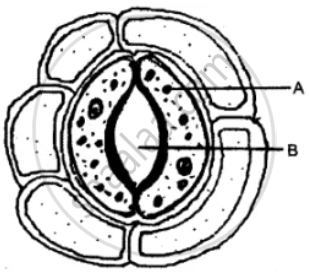Advertisements
Advertisements
Question
The figure below represents the vertical section of a leaf:

(i) Name the parts labeled 1 to 5.
(ii) What do the two arrows (dotted and solid) indicate in the day time and at night?
(iii) Could you add one more arrow in the figure? If yes, what for?
(iv) How many leaf veins have been shown in this section?
Solution
(i)
- Cuticle,
- Upper epidermis,
- Palisade tissue,
- Spongy parenchyma,
- Guard cell of a stoma.
(ii) In the day time dotted arrow shows the path of CO2 while solid arrow shows the path of oxygen. A night dotted arrow shows the path of oxygen while the solid arrow shows the path of CO2:
(iii) Yes, we can add one more arrow in the figure to show the loss of water during transpiration.
(iv) Only one leaf vein has been shown in this section.
APPEARS IN
RELATED QUESTIONS
Choose the correct answer:
Stomata open during day time because guard cells
Given ahead is a diagram of an experimental setup to study the process of transpiration in plants. Study the same and then answer the question that follows:

- Name the colour of dry cobalt chloride paper.
- Is the experimental leaf a monocot or a dicot? Give a reason to support your answer.
- Why are glass slides placed over the dry cobalt chloride papers?
- After about half an hour, what change, if any, would you expect to find in the cobalt chloride paper placed on the dorsal and ventral sides of the leaf? Give a reason to support your answer.
Given ahead is the diagram of an experimental set up to study the process of transpiration in plants. Study the same and then answer the questions that follow:

Is the experimental leaf a monocot or a dicot? Give a reason to support your answer.
The diagram below represents a structure found in a leaf.

Study the same and answer the questions that follow:
(i) Name the pis labeled A and B.
(ii) What is the biological term for the above structure?
(iii) What is the function of the part labeled A?
(iv) Mention two structural features of A, which help in the function mentioned in (iii) above.
(v) Where is this structure likely to be found in a leaf?
(vi) The above structure helps in the process of transpiration. Explain the term transpiration.
(vii) How many other cells are found surrounding this structure as seen in the diagram?
Given below is an experimental set up to study a particular process:

(i) Name the process being studied.
(ii) Explain the process named in (i) above.
(iii) Why is the pot covered with a plastic sheet?
(iv) Mention one way in which this process is beneficial to the plant.
(v) Suggest a suitable control for this experiment.
Name the following:
A plant having sunken stomata.
Complete the following sentence with appropriate word:
95% of the total transpiration takes place through ________.
Guard cells help in regulating the ______.
Define the following term:
Cuticle
Give a reason/suitable explanation.
More transpiration occurs from the under surface of a dicot leaf.
